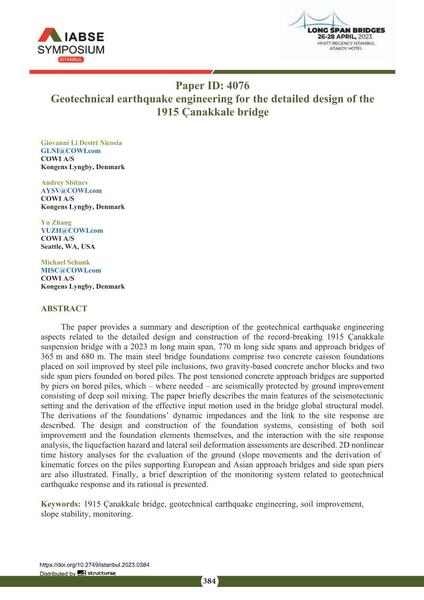Geotechnical earthquake engineering for the detailed design of the 1915 Çanakkale bridge

|
|
|||||||||||
Détails bibliographiques
| Auteur(s): |
Giovanni Li Destri Nicosia
(COWI A/S, Kongens Lyngby, Denmark)
Andrey Sbitnev (COWI A/S, Kongens Lyngby, Denmark) Yu Zhang (COWI A/S, Seattle, WA, USA) Michael Schunk (COWI A/S, Kongens Lyngby, Denmark) |
||||
|---|---|---|---|---|---|
| Médium: | papier de conférence | ||||
| Langue(s): | anglais | ||||
| Conférence: | IABSE Symposium: Long Span Bridges, Istanbul, Turkey, 26-28 April 2023 | ||||
| Publié dans: | IABSE Symposium Istanbul 2023 | ||||
|
|||||
| Page(s): | 384-391 | ||||
| Nombre total de pages (du PDF): | 8 | ||||
| Année: | 2023 | ||||
| DOI: | 10.2749/istanbul.2023.0384 | ||||
| Abstrait: |
The paper provides a summary and description of the geotechnical earthquake engineering aspects related to the detailed design and construction of the record-breaking 1915 Çanakkale suspension bridge with a 2023 m long main span, 770 m long side spans and approach bridges of 365 m and 680 m. The main steel bridge foundations comprise two concrete caisson foundations placed on soil improved by steel pile inclusions, two gravity-based concrete anchor blocks and two side span piers founded on bored piles. The post tensioned concrete approach bridges are supported by piers on bored piles, which – where needed – are seismically protected by ground improvement consisting of deep soil mixing. The paper briefly describes the main features of the seismotectonic setting and the derivation of the effective input motion used in the bridge global structural model. The derivations of the foundations’ dynamic impedances and the link to the site response are described. The design and construction of the foundation systems, consisting of both soil improvement and the foundation elements themselves, and the interaction with the site response analysis, the liquefaction hazard and lateral soil deformation assessments are described. 2D nonlinear time history analyses for the evaluation of the ground (slope movements and the derivation of kinematic forces on the piles supporting European and Asian approach bridges and side span piers are also illustrated. Finally, a brief description of the monitoring system related to geotechnical earthquake response and its rational is presented. |
||||
